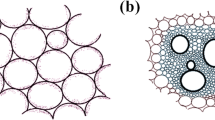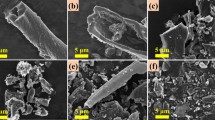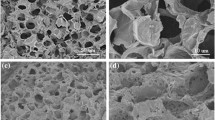Abstract
In this paper, highly porous carbon as an electrode material was derived from litchi pericarp (denoted as L-PC) via carbonization combined with KOH activation process. L-PC displayed high specific surface area (3438 m2 g−1) and high pore volume (1.92 cm3 g−1). The electrochemical capacitive properties of L-PC using KOH aqueous electrolyte were studied in three and two-electrode cells. The specific capacitance was 407 F g−1 in the three-electrode system at 1 A g−1, which was much higher than that of other biomass-derived porous carbon. In the two-electrode cell, the symmetric supercapacitors could work in a voltage window of 1.0 V. The highest specific capacitance of 70 F g−1 and energy density of 9.7 Wh kg−1 were exhibited in the two-electrode cells. About 98% of the initial capacitance was retained after 6000 cycles at 2.0 A g−1 in the cell. The highly porous carbon derived from litchi pericarp might act as an ideal electrode material for high performance supercapacitors.






Similar content being viewed by others

References
H. Feng, H. Hu, H. Dong, Y. Xiao, Y. Cai, B. Lei, Y. Liu, M. Zheng, Hierarchical structured carbon derived from bagasse wastes: a simple and efficient synthesis route and its improved electrochemical properties for high-performance supercapacitors. J. Power Sources 302, 164–173 (2016)
R. Wang, P. Wang, X. Yan, J. Lang, C. Peng, Q. Xue, Promising porous carbon derived from celtuce leaves with outstanding supercapacitance and CO2 capture performance. ACS Appl. Mater. Interfaces 4, 5800–5806 (2012)
Y. Li, G. Wang, T. Wei, Z. Fan, P. Yan, Nitrogen and sulfur co-doped porous carbon nanosheets derived from willow catkin for supercapacitors. Nano Energy 19, 165–175 (2016)
K. Sun, S. Yu, Z. Hu, Z. Li, G. Lei, Q. Xiao, Y. Ding, Oxygen-containing hierarchically porous carbon materials derived from wild jujube pit for high-performance supercapacitor. Electrochim. Acta 231, 417–428 (2017)
D. Guo, C. Zheng, W. Deng, X. Chen, H. Wei, M. Liu, S. Huang, Nitrogen-doped porous carbon plates derived from fallen camellia flower for electrochemical energy storage. J. Solid State Electrochem. 21, 1165–1174 (2017)
C. Peng, X. Yan, R. Wang, J. Lang, Y. Ou, Q. Xue, Promising activated carbon derived from waste tea-leaves and their application in high performance supercapacitors electrodes. Electrochim. Acta 87, 401–408 (2013)
X. Hao, J. Wang, B. Ding, Y. Wang, Z. Chang, H. Dou, X. Zhang, Bacterial-cellulose-derived interconnected meso-microporous carbon nanofiber networks as binder-free electrodes for high-performance supercapacitors. J. Power Sources 352, 34–41 (2017)
X. Zhang, C. Peng, R.-T. Wang, J.-W. Lang, Activated carbon from KOH and H3PO4-activation of olive residues and its application as supercapacitor electrodes. RSC Adv. 5, 32159–32167 (2015)
Q. Wang, M. Zhou, Y. Zhang, M. Liu, W. Xiong, S. Liu, Large surface area porous carbon materials synthesized by direct carbonization of banana peel and citrate salts for use as highperformance supercapacitors. J. Mater. Sci.: Mater. Electron. 29, 4294–4300 (2018)
Y.-T. Li, Y.-T. Pi, L.-M. Lu, S.-H. Xu, T.-Z. Ren, Hierarchical porous active carbon from fallen leaves by synergy of K2CO3 and their supercapacitor performance. J. Power Sources 299, 519–528 (2015)
C. Dai, J. Wan, W. Geng, S. Song, F. Ma, J. Shao, KOH direct treatment of kombucha and in situ activation to prepare hierarchical porous carbon for high-performance supercapacitor electrodes. J. Solid State Electrochem. 21, 2929–2938 (2017)
H. Yang, Y. Tang, X. Huang, L. Wang, Q. Zhang, Activated porous carbon derived from walnut shells with promising material properties for supercapacitors. J. Mater. Sci.: Mater. Electron. 28, 18637–18645 (2017)
G. Fu, Q. Li, J. Ye, J. Han, J. Wang, L. Zhai, Y. Zhu, Hierarchical porous carbon with high nitrogen content derived from plant waste (pomelo peel) for supercapacitor. J. Mater. Sci.: Mater. Electron. 29, 7707–7717 (2018)
Y. Zhai, Y. Dou, D. Zhao, P.F. Fulvio, R.T. Mayes, S. Dai, Carbon materials for chemical capacitive energy storage. Adv. Mater. 23, 4828–4850 (2011)
C. Liu, F. Li, L. Ma, H. Cheng, Advanced materials for energy storage. Adv. Mater. 22, E28–E62 (2010)
B. Xu, F. Wu, Y. Su, G. Cao, S. Chen, Z. Zhou, Y. Yang, Competitive effect of KOH activation on the electrochemical performances of carbon nanotubes for EDLC: balance between porosity and conductivity. Electrochim. Acta 53, 7730–7735 (2008)
H. Zhang, G. Cao, Y. Yang, Carbon nanotube arrays and their composites for electrochemical capacitors and lithium-ion batteries. Energy Environ. Sci. 2, 932–943 (2009)
A.G. Pandolfo, A.F. Hollenkamp, Carbon properties and their role in supercapacitors. J. Power Sources 157, 11–27 (2006)
M. Inagaki, New Carbon, Control of Structure and Functions (Elsevier, Amsterdam, 2000)
V. Presser, J. McDonough, S.-H. Yeon, Y. Gogotsi, Effect of pore size on carbon dioxide sorption by carbide derived carbon. Energy Environ. Sci. 4, 3059–3066 (2011)
M. Sevilla, A.B. Fuertes, Sustainable porous carbon with a superior performance for CO2 capture. Energy Environ. Sci. 4, 1765–1771 (2011)
Y. Zhu, S. Murali, M.D. Stoller, K.J. Ganesh, W. Cai, P.J. Ferreira, A. Pirkle, R.M. Wallace, K.A. Cychosz, M. Thommes, D. Su, E.A. Stach, R.S. Ruoff, Carbon-based supercapacitors produced by activation of graphene. Science 332, 1537–1541 (2011)
E. Raymundo-Piñero, P. Azaïs, T. Cacciaguerra, D. Cazorla-Amorós, A. Linares-Solano, F. Béguin, KOH and NaOH activation mechanisms of multiwalled carbon nanotubes with different structural organisation. Carbon 43, 786–795 (2005)
J. Jin, S. Tanaka, Y. Egashira, N. Nishiyama, KOH activation of ordered mesoporous carbon prepared by a soft-templating method and their enhanced electrochemical properties. Carbon 48, 1985–1989 (2010)
M.A. Lillo-Ródenas, D. Cazorla-Amorós, A. Linares-Solano, Understanding chemical reactions between carbon and NaOH and KOH: an insight into the chemical activation mechanism. Carbon 41, 267–275 (2003)
H. Liu, K. Wang, H.A. Teng, Simplified preparation of mesoporous carbon and the examination of the carbon accessibility for electric double layer formation. Carbon 43, 559–566 (2005)
Y.A. Alhamed, H.S. Bamufleh, Sulfur removal from model diesel fuel using granular activated carbon from dates’ stones activated by ZnCl2. Fuel 88, 87–94 (2009)
C. Hsieh, Y. Lin, Synthesis of mesoporous carbon composite and its electric double-layer formation behavior. Microporous Mesoporous Mater. 93, 232–239 (2006)
K. Wang, H. Teng, The performance of electric double layer capacitors using particulate porous carbon derived from PAN fiber and phenol-formaldehyde resin. Carbon 44, 3218–3225 (2006)
S. Chun, J.F. Whitacre, The evolution of electrochemical functionality of carbon derived from glucose during pyrolysis and activation. Electrochim. Acta 60, 392–400 (2012)
K. Zhang, L.L. Zhang, X.S. Zhao, J. Wu, Graphene/polyaniline nanofiber composites as supercapacitor electrodes. Chem. Mater. 22, 1392–1401 (2010)
R.B. Rakhi, D. Cha, W. Chen, H.N. Alshareef, Electrochemical energy storage devices using electrodes incorporating carbon nanocoils and metal oxides nanoparticles. J. Phys. Chem. C 115, 14392–14399 (2011)
Y. Wang, Z.Q. Shi, Y. Huang, Y.F. Ma, C.Y. Wang, M.M. Chen, Y.S. Chen, Supercapacitor devices based on graphene materials. J. Phys. Chem. C 113, 13103–13107 (2009)
Y. Gao, Y.S. Zhou, M. Qian, X.N. He, J. Redepenning, P. Goodman, H.M. Li, L. Jiang, Y.F. Lu, Chemical activation of carbon nano-onions for high-rate supercapacitor electrodes. Carbon 51, 52–58 (2011)
Acknowledgements
This work was supported by the National Natural Science Foundations of China (Grant Nos. 21663026, 51462031, 11564034, 11764036), the National Natural Science Foundation of Gansu Province (Grant Nos. 1606RJZA064, 17JR5RA283) and Project of Science and Technology of Gansu Province (Grant No. 17YF1GA025). This work was also supported by the Central Universities Basic Service Fee (Grant Nos. 31920150010, 31920150243, 31920150244 and 31920170008).
Author information
Authors and Affiliations
Corresponding author
Electronic supplementary material
Below is the link to the electronic supplementary material.
Rights and permissions
About this article
Cite this article
Wang, P., Zhang, G., Chen, W. et al. Highly porous carbon derived from litchi pericarp for supercapacitors application. J Mater Sci: Mater Electron 29, 14981–14988 (2018). https://doi.org/10.1007/s10854-018-9636-5
Received:
Accepted:
Published:
Issue Date:
DOI: https://doi.org/10.1007/s10854-018-9636-5



